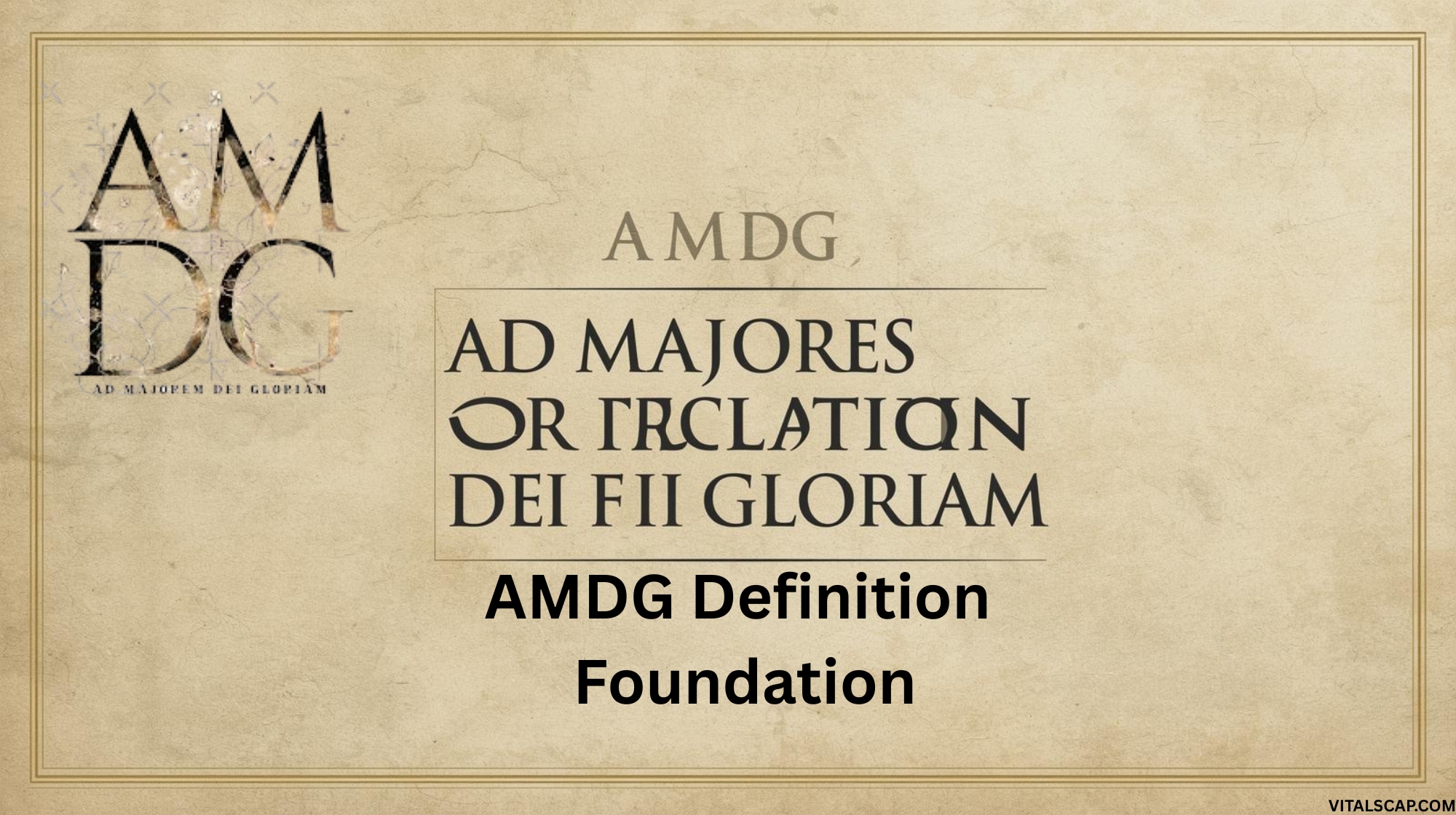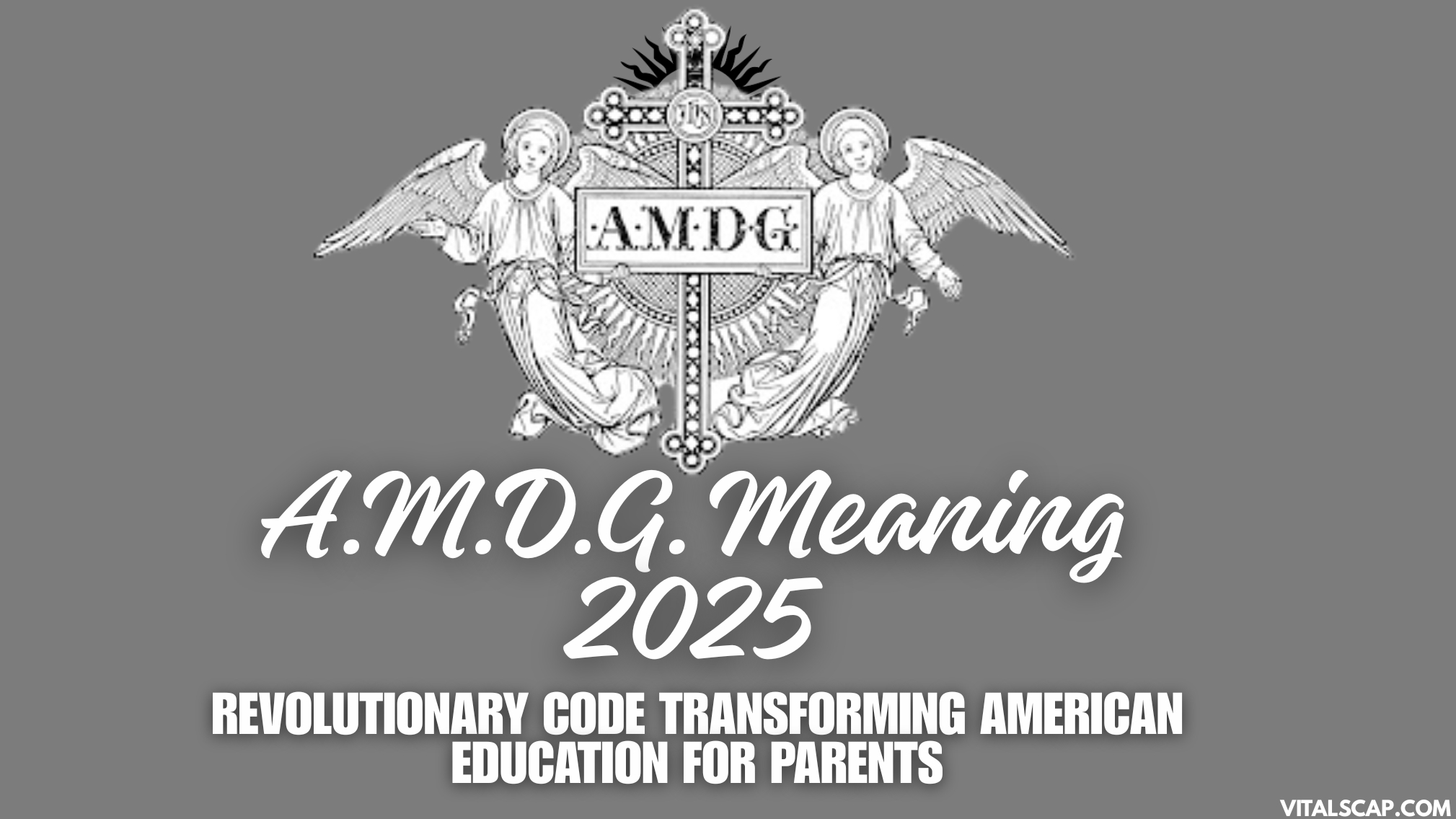You’ve seen these mysterious letters etched into Georgetown University’s stone facades and printed atop Boston College assignment papers. But do you truly understand their transformative power? A.M.D.G. isn’t just another abbreviation. It’s a 500-year-old philosophy that’s quietly revolutionizing how Americans approach excellence, education, and personal fulfillment in 2025.
These four letters appear on million-dollar university buildings, inspire AMDG tattoo designs among alumni, and guide educational decisions affecting millions of American students. Yet most people don’t grasp their profound meaning or life-changing potential.
AMDG Definition Foundation

A.M.D.G. stands for “Ad Majorem Dei Gloriam,” which translates directly as “For the greater glory of God.” This Latin phrase serves as the official spiritual motto of the Jesuit order, but its impact extends far beyond religious significance. The definition encompasses a complete philosophy of intentional living and purpose-driven excellence.
The abbreviation represents more than simple Catholic tradition. It’s a framework for approaching every task, relationship, and decision with heightened consciousness and deliberate excellence. Understanding this acronym opens doors to deeper interpretation of success itself.
| Component | Latin | English | Practical Application |
| Ad | To/For | Direction | Purposeful action |
| Majorem | Greater | Excellence | Beyond mediocrity |
| Dei | Of God | Divine | Higher purpose |
| Gloriam | Glory | Honor | Meaningful impact |
Key Points About A.M.D.G. Definition:
- Not exclusive to Catholic believers
- Emphasizes quality over quantity
- Transforms ordinary work into extraordinary service
- Creates sustainable motivation systems
AMDG Revolutionary Philosophy
The meaning behind AMDG goes deeper than most people realize. “All of our actions should continue to glorify God. In our context, that translates into going more deeply into the knowledge that we encounter in our studies” according to Jesuit educational philosophy. This interpretation revolutionizes how Americans approach learning, work, and personal growth.
Modern AMDG meaning challenges our culture’s obsession with individual achievement. Instead of working harder, it asks you to work with greater intention. The spiritual motto doesn’t demand religious belief but invites everyone toward excellence that serves something larger than personal gain.
Core Elements of AMDG Meaning:
- Intentionality over intensity
- Service orientation
- Continuous improvement mindset
- Holistic excellence approach
What Does AMDG Stand For?
“Ad Majorem Dei Gloriam” represents the heart of Jesuit philosophy, but there’s more to discover. The complete phrase includes “inque hominum salutem” (and for the salvation of humankind), revealing the outward-facing dimension most Americans never learn about.
This extended meaning transforms the acronym from personal spiritual practice into social responsibility. Your pursuit of excellence isn’t self-serving; it’s meant to benefit the entire human family through your contributions to society, workplace, and community.
What AMDG Stands For in Practice:
- Personal excellence for collective benefit
- Academic achievement with social purpose
- Professional success through service
- Faith and devotion expressed through action
AMDG Abbreviation
The AMDG abbreviation appears across American Catholic institutions, from elementary AMDG school headers to university AMDG logo designs. Students at Jesuit institutions learn to begin assignments with these letters, creating psychological anchors that transform mundane homework into meaningful offerings.
Modern AMDG abbreviation usage extends beyond educational settings. Alumni often incorporate the letters into personal branding, business logos, and even AMDG tattoo designs as permanent reminders of their philosophical commitment.
Contemporary AMDG Abbreviation Usage:
- Digital signatures and email footers
- Social media hashtags and profiles
- Corporate mission statements
- Personal goal-setting frameworks
A.M.D.G. in American English
A.M.D.G. Catholic tradition in American English emphasizes the abbreviation’s practical applications rather than purely theological interpretation. American Jesuit educators focus on how the motto develops character, critical thinking, and social responsibility among students from diverse backgrounds.
The American interpretation of A.M.D.G. often connects with national values of service, excellence, and community contribution. This cultural symbolism resonates with Americans seeking purpose beyond material success.
American English Characteristics:
- Emphasis on practical application
- Integration with secular excellence principles
- Focus on community service
- Connection to American volunteer tradition
AMDG in British English

AMDG usage in British English maintains closer ties to Catholic Church tradition and formal theological interpretation. British Jesuit institutions emphasize the motto’s contemplative aspects, encouraging deeper reflection on spiritual meaning before action.
The British approach to AMDG often includes more formal pronunciation guidance and stronger emphasis on Latin language accuracy in educational settings.
Word History and Origins
Saint Ignatius of Loyola created this spiritual motto during his 1521 recovery from battle wounds at Pamplona. The Spanish soldier’s spiritual transformation birthed the Jesuit order in 1540, establishing Ad Majorem Dei Gloriam as their guiding principle for education and ministry worldwide.
The history reveals how personal crisis sparked global educational revolution. Saint Ignatius’ origin story demonstrates how individual transformation can impact millions of lives across centuries. His interpretation of divine service through excellence continues shaping American education today.
Historical Timeline:
- 1521: Ignatius wounded at Pamplona
- 1522-1523: Spiritual awakening and conversion
- 1540: Jesuit order officially founded
- 1548: First Jesuit schools established
- 1789: Georgetown University founded in America
Ad Majorem Dei Gloriam
“Ad Majorem Dei Gloriam” represents the briefest summary of Jesuit spirituality according to traditional sources. “This phrase is what impells Jesuits to try their best in the service of the Kingdom of God: to help all men and women come to the knowledge of God’s love” as explained by Jesuit spiritual directors.
The Latin phrase carries linguistic precision that English translation sometimes loses. Each word contributes specific meaning: “Ad” indicates direction, “Majorem” demands excellence, “Dei” provides divine context, and “Gloriam” defines the ultimate purpose.
Expert Insight: According to Jesuit educational philosophy, “Everything is for God’s greater glory. We are reminded to live our lives for God’s greater glory” which transforms ordinary activities into meaningful spiritual practice.
AMDG: The Real Meaning Behind a Jesuit Motto
The real meaning behind AMDG challenges American assumptions about success and achievement. Rather than pursuing personal glory, the Jesuit motto redirects energy toward excellence that serves others. This interpretation has produced remarkable outcomes in American Jesuit institutions for centuries.
AMDG’s authentic meaning emphasizes process over results. Students learn to approach assignments, relationships, and challenges with greater intentionality. The motto doesn’t promise easier paths but transforms how Americans experience difficulty, setbacks, and victories.
Real Meaning Applications:
- Excellence without ego
- Service before self
- Process-focused achievement
- Community-centered success
One Thought on “What does AMDG mean?”
Individual experiences with AMDG Meaning reveal its transformative potential for American families. Parents report that teaching children this philosophy shifts household dynamics from competition to collaboration. Students discover sustainable motivation that outlasts external rewards and pressures.
The spiritual motto provides frameworks for difficult decisions. Whether choosing colleges, careers, or life partners, AMDG offers clarity by asking: “Which option serves the greater good while honoring my authentic gifts?” This question revolutionizes decision-making processes.
Where Did AMDG Come From? (A Brief History)
AMDG emerged from Saint Ignatius of Loyola’s profound spiritual awakening during his 1521-1523 convalescence. The Spanish knight’s transformation from worldly ambition to divine service created educational methodologies still used in American Jesuit institutions today.
The Jesuit order’s rapid expansion brought AMDG philosophy to global education systems. By 1773, Jesuits operated 800 educational institutions worldwide before papal suppression temporarily halted their mission.
Why Did We Choose AMDG?
American Jesuit institutions chose AMDG because it produces measurable outcomes in student character development and academic achievement. Georgetown University, Boston College, and other prestigious schools report higher graduation rates, stronger alumni networks, and increased community service participation among students embracing this philosophy.
The motto addresses modern educational challenges including student stress, purposelessness, and competitive toxicity. AMDG creates sustainable excellence frameworks that serve students throughout their careers and personal lives.
How to Pronounce Ad Majorem Dei Gloriam?
AMDG pronunciation in American English follows these guidelines: “Ahd MAH-yor-em DAY-ee glor-ee-AHM.” Many Catholic schools teach proper Latin language pronunciation to preserve traditional accuracy while making the phrase accessible to diverse student populations.
Pronunciation mastery helps students internalize the motto’s meaning more effectively. When you can speak “Ad Majorem Dei Gloriam” confidently, you’re more likely to remember its principles during challenging moments.
Pronunciation Tips:
- Emphasize the “MAH” in Majorem
- Soft “g” sound in gloriam
- Practice with Latin pronunciation apps
- Listen to Jesuit liturgical recordings
Meaning of BVMH
BVMH stands for “Beata Virgo Maria Help” (Blessed Virgin Mary Help), representing another important abbreviation in Catholic education. While AMDG focuses on divine glory through action, BVMH emphasizes seeking assistance through Marian intercession.
Understanding BVMH alongside AMDG provides comprehensive insight into Catholic cultural symbolism. Both acronyms appear in American Jesuit schools, creating layered spiritual meaning that enriches educational experiences.
Meaning of IHS
IHS represents the first three letters of Jesus’ name in Greek, often translated as “Jesus, Savior of Humanity.” This acronym frequently appears alongside AMDG in Jesuit institutions, creating visual reminders of Christian faith and devotion principles.
The combination of IHS and AMDG symbols provides complete theological context for Jesuit education. Students encounter both abbreviations daily, reinforcing connections between personal spiritual growth and academic excellence.
AMDG: The Real Meaning Behind a Jesuit Motto
Jesuit educators emphasize that AMDG’s real meaning transcends simple religious observance. The motto challenges students to discover their authentic gifts and use them for community benefit. This approach has produced exceptional leaders across American business, politics, and social justice movements.
Expert testimonials from Jesuit institutions consistently highlight AMDG’s impact on student character development. “Ad Majorem Dei Gloriam calls for actions that glorify a higher purpose” according to Loyola University Chicago’s student development philosophy.
Modern Applications in American Education

AMDG Jesuit schools across America implement this philosophy through innovative practices. Students write AMDG on assignments, participate in service learning, and engage in reflective discussions about purpose and meaning. These practices create distinctive educational experiences that prepare students for meaningful careers.
AMDG school traditions include:
- Assignment dedication practices
- Community service requirements
- Leadership development programs
- Spiritual reflection opportunities
The “For the greater glory of God” meaning translates into practical excellence standards that benefit entire school communities while developing individual potential.
Practical Implementation Guide
Living AMDG meaning in 2025 requires practical strategies that work for busy American families. Start by incorporating reflection questions into daily routines: “How can this action serve something greater than myself?” This simple practice transforms ordinary moments into opportunities for growth and service.
AMDG Catholic families often adapt the tradition by beginning family meals with gratitude discussions or ending days by reflecting on how they served others. These practices don’t require deep theological knowledge but create meaningful frameworks for intentional living.
Implementation Strategies:
- Morning intention setting
- Evening reflection practices
- Family service projects
- Workplace excellence standards
Expert Recommendations and Professional Insights
Jesuit education experts consistently recommend AMDG principles for developing resilient, purpose-driven students. “Be attentive, be reflective, be loving” represents Boston College’s interpretation of Jesuit education core values, demonstrating how AMDG meaning shapes practical educational approaches.
Professional development coaches increasingly incorporate AMDG principles into leadership training programs. The philosophy addresses workplace challenges including burnout, lack of purpose, and toxic competition by redirecting focus toward service-oriented excellence and collaborative achievement.
Cultural Impact and Modern Relevance
AMDG cultural symbolism resonates strongly with American values of service, innovation, and community contribution. The motto provides antidotes to modern challenges including social media comparison, achievement anxiety, and purposelessness among young adults.
2025 trends show increasing interest in meaningful work and purpose-driven careers among American professionals. AMDG philosophy offers frameworks for pursuing ambitious goals while maintaining ethical standards and community focus.
Global Influence and American Leadership
American Jesuit universities produce disproportionate numbers of leaders in business, politics, and social justice. This success stems from AMDG meaning integration throughout educational experiences. Students learn to view leadership as service opportunity rather than personal advancement.
The Jesuit order’s global network creates international perspectives that enrich American education. Students understanding AMDG meaning develop cross-cultural competencies and global service orientations that benefit American communities and international relations.
Frequently Asked Questions
Is AMDG a Jesuit?
AMDG serves as the official motto of the worldwide Jesuit order, representing their spiritual and educational mission.
What does AMDG mean in Jesuit High school?
Students write AMDG on assignments, dedicating academic work to God’s glory while pursuing personal excellence.
What is the meaning of AMDG in Ateneo?
Ateneo universities embrace AMDG to combine rigorous academics with character formation and community service commitments.
What does the Jesuit motto mean?
The Jesuit motto encourages pursuing excellence in all endeavors for God’s greater glory and humanity’s welfare.
What does the Catholic term AMDG mean?
Catholic AMDG represents dedication of work and life to God’s glory, emphasizing service over self-advancement.
What does fiat mean in Catholic?
Fiat means “let it be done,” expressing acceptance of God’s will, complementing AMDG’s active pursuit.
Conclusion
A.M.D.G. meaning offers revolutionary approaches to American education and personal development in 2025. This ancient spiritual motto provides timeless wisdom for modern challenges, transforming how families approach excellence, service, and community contribution.
Whether you’re Catholic or secular, parent or student, professional or volunteer, AMDG principles can guide you toward meaningful achievement that serves both personal growth and collective good. The question isn’t whether you’ll succeed, but how your success will serve others.
More Post:

Passionate about innovation and growth. Dedicated to managing, optimizing, and creating seamless experiences while supporting diverse content and users with professionalism and clarity every day.








